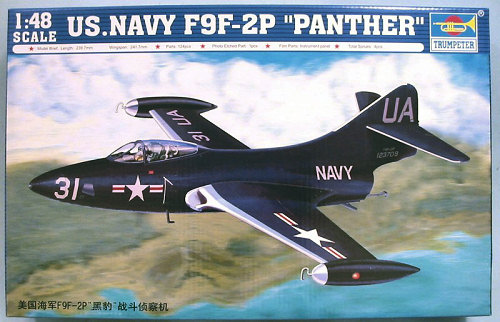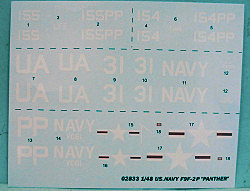
| KIT: | Hobbycraft/Trumpeter 1/48 F9F-2/2P Panther |
| KIT #: | 2832/33 |
| PRICE: | $39.95 |
| DECALS: | ? |
| REVIEWER: | Tom Cleaver |
| NOTES: | New Mold |

| HISTORY |
What became the Grumman Panther was first designed as a four-jet night fighter that resembled the Curtiss XF-87 Nighthawk. This was due to the fact that early jet engine development under Navy sponsorship made a false start. One of the first engines available to Grumman designers at the end of the Second World War was the 1,500 lb thrust Westinghouse 130; in order to achieve the required performance it would be necessary to install four of these engines in the original Grumman design, which was designated XF9F-1. The development contract was issued on April 22, 1946, but further design work revealed that the airplane would not meet the specifications.
By 1947, the British Nene engine was available, producing nearly four times the thrust of the Westinghouse engine. Grumman determined that using a single Nene would allow them to produce a day fighter that had significantly better performance than either the FH-1 Phantom or the FJ-1 Fury that were then in limited operational use by the Navy. The Navy agreed and Pratt & Whitney obtained a license to produce the British engine as the J42. The designation became XF9F-2, and Corky Meyer flew the first prototype on November 24,1947, powered by a Nene providing 5,750 pounds of thrust. The prototype was very close to “right” all the way around as originally flown, other than needing permanently-mounted wingtip fuel tanks, which improved the roll rate. The F9F-2, now known as the “Panther,” was cleared for carrier operation in September 1949 and entered service that November with VF-51.
The entry of the Panther into service came just in time. Seven months later the Panther was involved in a shooting war following the North Korean invasion of South Korea on June 25, 1950. On June 27, President Truman authorized American forces to enter combat and the USS “Boxer,” with VF-51 aboard, which had moved into the Sea of Japan immediately following the outbreak of hostilities, launched the first Navy air strike that same day. VF-51's Panthers flew as fighter escort to the Corsair and Skyraider attack squadrons in a strike on the airfield at Pyongyang, the North Korean capitol.
On July 3, LT (jg) Leonard H. Plog scored the first U.S. air victory of the war when he shot down a North Korean Yak-9. Two days later another Yak-9 was shot down over Seoul. On November, 9, 1950 LCDR William Amen, CO of VF-111 "Sundowners" shot down a MiG-15 when his division was attacked while flying escort near the Yalu River. Amen reported that the MiG completely outclassed the F9F-2, and that he and his wingman had only barely been able to stay in range behind the MiG he shot down. Two more MiG-15s were shot down on November 18, 1950, while two more were shot down two years later to the day on November 18, 1952. In all five cases, the victories were due to superior pilot training and experience on the part of the Navy pilots.
Despite its limitations, the Panther was the main naval jet aircraft used throughout the Korean War, flying 78,000 sorties between June 27, 1950 and July 30, 1953.
There are at least four F9F-2 Panthers left in existence, one on display at the Marine Corps Museum in Quantico, Virginia, one at the National Museum of Naval Aviation in Pensacola, Florida, one at NAS Willow Grove in Pennsylvania, and BuNo 123708, owned by the Cavanaugh Flight Museum in Addison Texas, which was restored to flight status in 1995 and is the only flying Panther in the world.
| THE KIT |
 Modelers have been waiting for four years to see this F9F-2, since the kit was
first announced by Hobbycraft. Due to corporate difficulties, Hobbycraft was
only able to get this out the door by partnering with Trumpeter. These two
releases by Trumpeter will be followed in approximately 6-8 weeks by release of
the kits by Hobbycraft.
Modelers have been waiting for four years to see this F9F-2, since the kit was
first announced by Hobbycraft. Due to corporate difficulties, Hobbycraft was
only able to get this out the door by partnering with Trumpeter. These two
releases by Trumpeter will be followed in approximately 6-8 weeks by release of
the kits by Hobbycraft.
Interestingly, the two kits are virtually the same, other than for decals. The F9F-2P kit includes both the photo nose and fighter nose, and full ordnance. Modelers who choose to do the F9F-2P should be aware that the airplane seldom (if ever) carried under wing ordnance, despite the instructions in the kit. (Editor's note; I've not shown that sprue or the one for the clear bits. There are a lot of ordnance options if you wish to go that route)
Overall, Hobbycraft appears to have gotten it right as concerns overall shape, including such little-known items as the lower keel/fin just ahead of the tail bumper. The cockpit accurately represents the side panel and instrument panel detail of an F9F-2, which differs in small but important ways from the F9F-5.
The canopy is better than other F9F kits in that it finally gets the higher cross section right, though it is incorrect in that the forward edge of the canopy should be at 90 degrees to the plane of the base of the canopy, rather than 90 degrees to the aircraft centerline, as it is. This is a fairly minor point, and those modelers who want to correct this could do so by sanding the canopy and windscreen to the proper angles, though this will then require that the canopy be posed in the open position and the framing be rescribed.
The other mistake in the kit is that the intakes are too small. This is also easily solved with a rat tail file and about 5 minutes’ work to extend the intake about 1/32 inch further outboard.
For this reviewer, the big problem was the work of Trumpeter’s “Mad Riveter”,
with small divots masqu erading as “flush rivets” all over the airframe. While
they aren’t at the “dark side of the moon” level of the godawful Dragon P-51D,
in 1/48 scale this is entirely incorrect; the rivets on the real thing (we have
one out at Chino) are invisible under paint from a distance further than 12 inches (1/4 inch in 1/48 scale). Fortunately, I discovered upon assembling the
kit that sanding down the model overall will reduce the rivets to virtual
non-existence once the model is polished out. A modeler could get rid of them
entirely with additional sanding, but I found light sanding to knock them off by
about 80% results in a nice overall look.
erading as “flush rivets” all over the airframe. While
they aren’t at the “dark side of the moon” level of the godawful Dragon P-51D,
in 1/48 scale this is entirely incorrect; the rivets on the real thing (we have
one out at Chino) are invisible under paint from a distance further than 12 inches (1/4 inch in 1/48 scale). Fortunately, I discovered upon assembling the
kit that sanding down the model overall will reduce the rivets to virtual
non-existence once the model is polished out. A modeler could get rid of them
entirely with additional sanding, but I found light sanding to knock them off by
about 80% results in a nice overall look.
The decals are what one has come to expect from Trumpeter, and are best thrown in the waste basket. There are no stencil decals, and the sizes and shapes of the letters and numbers on what is there do not correspond to any font ever used by the US Navy.
| CONCLUSIONS |
I am pleasantly surprised to report that this is the best Hobbycraft release since their P-26 series. The two minor shape problems are easily solved for those who consider them important, and the work of the Mad Riveter is easily turned into history with 20 minutes spent with sandpaper and rubbing compound. Past that, the kit makes up into an accurate Panther. My recommendation is that you buy the kit and wait for the release of the undoubted plethora of aftermarket decals that should be available in a matter of months.
This kit bodes well for the rest of the F9F series that was announced by Hobbycraft and I would say modelers can safely take a pass on the Fonderie Miniatures Cougar and wait for the Hobbycraft/Trumpeter release.
Review kit courtesy of Stevens International.
February 2007
If you would like your product reviewed fairly and quickly by a site that has nearly 350,000 visitors a month, please contact me or see other details in the Note to Contributors.